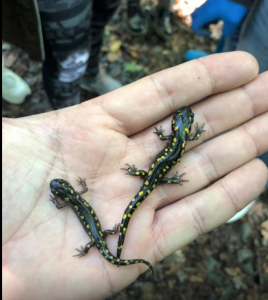Salamanders and Spring Peepers
Salamanders and Spring Peepers by Jessica Kratz
Whereas turtles want to soak up the sun, warm rains above 42 degrees are what wake up sleepy salamanders and frogs. On wet early spring evenings, salamanders slither to their breeding grounds. It is important to drive slowly if you are near woodlands and swamps during such evenings.
Some things are worth melting for, and as winter melts into spring, we may begin to hear a chorus of spring peepers, or as I like to call them, “sleigh bells in springtime.” Our Greenbelt ponds and swamps will come alive with the sound of music. The loud symphony is a harbinger of spring. A high-pitched chorus of frogs calling.
Most frogs bury themselves in mud to keep their body temperatures above freezing. Not the peeper. It hibernates under leaf litter and logs. When temperatures dip below freezing, the frog’s liver begins to flood the blood stream with massive amounts of glucose, which prevents cell damage even when most of its body is frozen. During this time, the frog’s heart stops beating and it appears dead. But the clock is ticking: One study found 85 percent of frogs survived three days in the state, while 50 percent survived for a week. – William Dendis
Click here to read all about Spring Peepers.
Jessica Kratz is the Greenbelt Nature Center Coordinator, an award winning poet and writer and the author of two children’s books, including “Sleigh Bells in Springtime,” which is based on the spring peeper emergence

